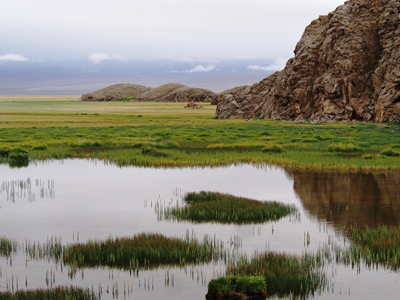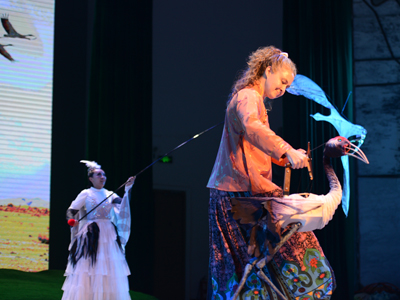 In late summer I joined over 90 participants at a remote nature reserve in north-central China to share research and experience focusing on Black-necked Crane conservation. The Fifth Annual Black-necked Crane Network Meeting was held at Yanchiwan National Nature Reserve in Gansu Province. Located on the northern edge of the Tibet-Qinghai Plateau in the western Qilianshan Mountains, the reserve was designated to protect the Vulnerable White-lipped Deer and Black-necked Crane. The site is the northern-most breeding area for Black-necked Cranes, and in recent years reserve staff has recorded about 150 cranes, with 40-50 breeding pairs.
In late summer I joined over 90 participants at a remote nature reserve in north-central China to share research and experience focusing on Black-necked Crane conservation. The Fifth Annual Black-necked Crane Network Meeting was held at Yanchiwan National Nature Reserve in Gansu Province. Located on the northern edge of the Tibet-Qinghai Plateau in the western Qilianshan Mountains, the reserve was designated to protect the Vulnerable White-lipped Deer and Black-necked Crane. The site is the northern-most breeding area for Black-necked Cranes, and in recent years reserve staff has recorded about 150 cranes, with 40-50 breeding pairs.
The network meeting focused on an overview of cranes in China and in the world; conservation, education, and management in support of Black-necked Cranes; crane research and monitoring; and Black-necked Crane site exchange and networking. As 2016 is the centennial for the U.S. National Park Service, Heidi Hartman from the U.S. Consulate General-Chengdu further introduced the history and visitor programs of the U.S. national parks.
Environmental Education programs have become one of the key shared topics as the network has developed. The related presentations and discussions focused on how to make research results available and understandable to educators. We also discussed how researchers need to be involved in public education activities, as research integrated with education can make conservation much more effective. As a result of these discussions, a new Chinese-language website has been created to serve as a portal for updates on Black-necked Crane news, as well as information exchange through the messaging tool WeChat.
The meeting included presentations on environmental education activities implemented by the International Crane Foundation in the U.S. and China. Educators from schools, reserves and non-profit organizations in the U.S., Beijing, Cao Hai and Ruoergai National Nature Reserves, and Tibet shared their experiences with environmental camps, school curricula, teacher training, visitor programs, and outreach to stop illegal Whooping Crane shootings in the U.S. In addition to the presentations, educators from the International Crane Foundation and several Black-necked Crane range provinces met separately to discuss what they had learned during the meeting and planned future environmental education activities.

We also enjoyed an evening performance of Beautiful Yanchiwan and Loving Black-necked Cranes prepared by Yanchiwan reserve staff and American artist Heather Henson, which included a dance of Black-necked Cranes, crane kites, and a crane toy theater. The evening combined art and crane conservation beautifully. The reserve staff had practiced for months!
The network meeting was organized by the Gansu Forestry Department, International Crane Foundation, Kunming Institute of Zoology of the Chinese Academy of Sciences, and National Bird Banding Center of China. Participants traveled to the workshop from throughout China, as well as the U.S. and India, including Jim Harris, Senior Vice President of the the International Crane Foundation, Lu Jun, Director of the National Bird Banding Center, Zhang Ping, Deputy Director of the Gansu Forestry Department, and Pankaj Chandan, Team Leader of theWestern Himalayas Landscape of World Wildlife Fund-India.
We ended the meeting by discussing dates, locations and themes for our next event. Dashanbao National Nature Reserve and Huize National Nature Reserve, both in Yunnan Province in southeast China, offered to host the next network meeting. Depending on the location, we will then decide on the themes for the anticipated event.
 Story submitted by Dr. Li Fengshan, International Crane Foundation Yangtze Program and Black-necked Crane Program Leader. Learn more about our East Asia program.
Story submitted by Dr. Li Fengshan, International Crane Foundation Yangtze Program and Black-necked Crane Program Leader. Learn more about our East Asia program.
